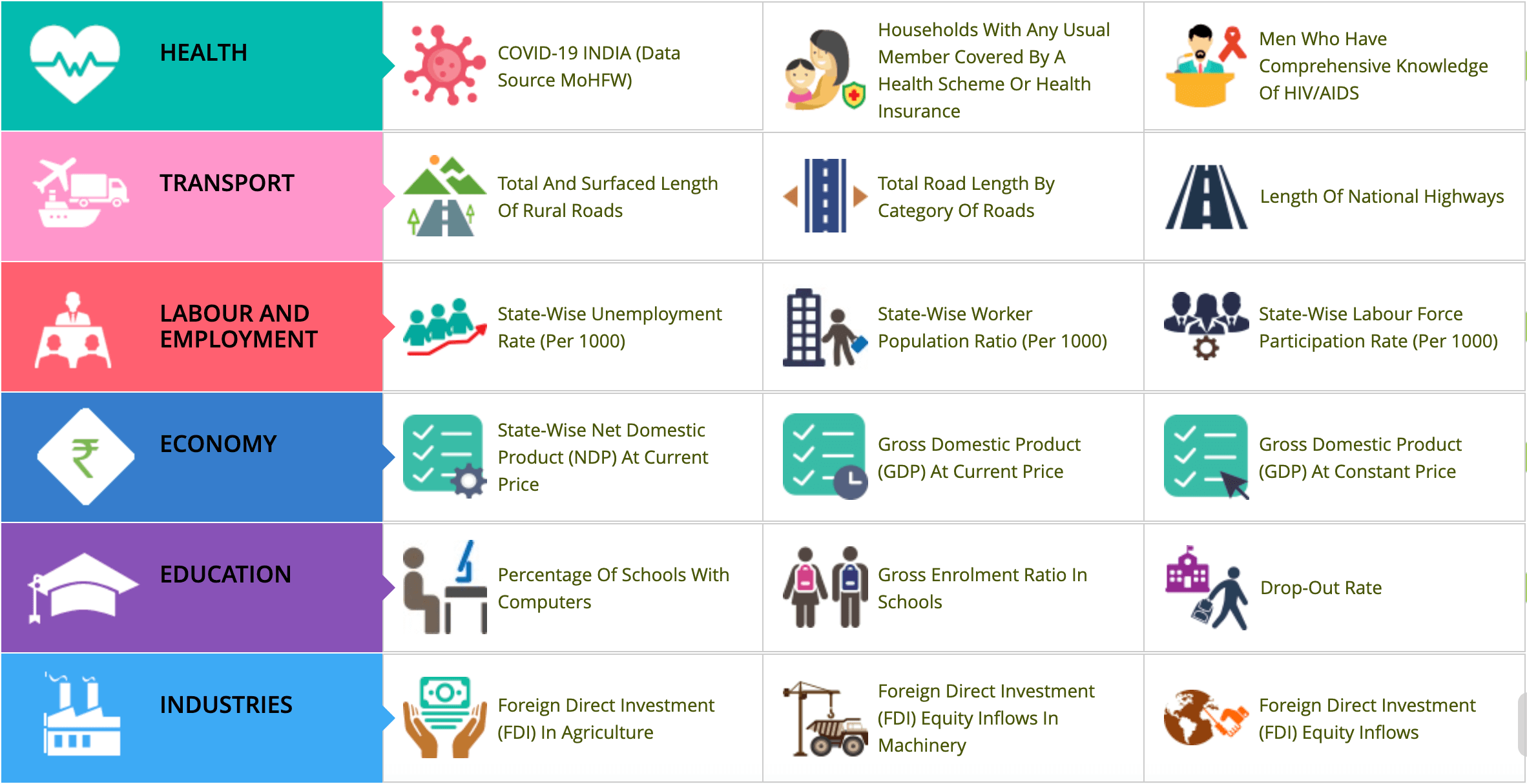Open Government Data, often referred to as Open Data, is a philosophy and public policy program premised by the notion that access to data that is collected by the government using public funds should be democratized. In practice, governments utilize mechanisms like law, policy, executive action, regulation, and guidelines, in order to produce Open Data repositories accessible to citizens via the internet. To date, more than 250 governments at national, subnational, and city levels have launched Open Data initiatives, with varying levels of success.
In 2012, the Government of India launched the country’s Open Data program via the National Data Sharing and Accessibility Policy (NDSAP). It defines data as a representation of information, numerical compilations and observations, documents, facts, maps, images, charts, tables, and figures. To facilitate this policy, NDSAP stipulated that the National Informatics Centre launch the Open Government Data Platform. While technically remaining the property of the institution that collected it, the Open Government Data Platform hosts data online, where it can be accessed and downloaded for further use by the public.
Open Data can hold tremendous value for a range of sectors and use-cases. For example, data on commodity prices, soil health, precipitation, and other climatic factors could be leveraged by civic technologists to help farmers make more informed decisions on pricing and selling crops. Real estate developers could use topographical, geospatial, climatic, and flooding data to evaluate the risk of building in a particular area. Civil society organizations can analyze data on social welfare programs and public health to identify gaps in healthcare provision for the poor. In just seven sectors, McKinsey estimates that Open Data poses to unlock an additional $3 trillion a year in economic value. This projection speaks to the enormous, unrealized potential of Open Data in areas of economic and social consequence.disparate

By acting as a refined well of datasets from various sectors, Open Data was envisioned as a means of driving improved decision making and innovation in Indian government, civil society, as well as the scientific, technological, and business communities. Unfortunately, almost 10 years after its launch, India’s Open Data program is hindered by issues of quality, disparate standardization, and gaps in high-value data. As a result, despite serving as a viable repository and hosting thousands of datasets, the Open Government Data Platform’s usefulness is significantly limited and the potential of Open Data in India remains untapped to a great extent.
Fundamental Deficiencies in Mandate, Accountability, and Capacity
The laggard status of Open Data is largely a product of the discretionary nature of the National Data Sharing and Accountability Policy (NDSAP) 2012, from which the nation’s Open Data mandate is derived. The NDSAP directs that Chief Data Officers (CDOs) be appointed as nodal Open Data personnel at each government agency, be it the Ministry of Textiles or the Ministry of Agriculture and Farmers Welfare. In turn, CDOs are responsible for appointing a dedicated team and curating their institution’s flow of data. While technical procedures for contributing datasets to the Open Government Data Platform are clear, the criteria for identifying and selecting datasets is high-level and limited to basic principles.
Operating in an environment of relative ambiguity, results have been lacking to date. Deadlines set by the NDSAP for producing datasets have not been met; in fact, many high-value datasets are still languishing in institutional servers, spreadsheets, or non-digital formats. Datasets that are available are sometimes outdated, incomplete, or in disparate formats, making their use challenging.
However, given that the NDSAP did not create any substantive penalties or incentive measures predicated on performance, CDOs and other Open Data personnel do not face any meaningful, systemic accountability in the event of non-compliance. Even more, there are potentially perverse incentives for performance; given that Open Data is poised to generate increased transparency and accountability for government agencies, CDOs may be motivated to drag their feet.
This challenging policy environment is compounded by gaps in institutional and human capacity, as well as bureaucratic buy-in. CDOs, who are generally Joint Secretary-level personnel, are allotted the responsibility of handling a government institution’s open data in addition to their existing work portfolio. Consequently, Open Data becomes a de facto secondary concern — one that unlike their primary role is not subject to any substantive accountability from superiors in the institutional hierarchy. According to Gaurav Godhwani, Director & Co-founder of CivicDataLab, “most government departments are over-worked with their existing responsibilities, and Open Data work comes as an additional burden on already tired shoulders.”
Moreover, although the NDSAP requires each institution to appoint a CDO, the Open Government Data Platform’s CDO page reflects that dozens of Union Government posts remain vacant. In many cases, there are also issues with an institution’s in-house capacity to effectively collect and reposit data. In sum, a government agency’s performance in Open Data is presently subject to the discretion, motivation, and capacity of the CDO and their team.
Presenting the Need for Legislation
The precedent of the passage of the Right to Information (RTI) Act in 2005 provides a practical basis for Open Data legislation. Prior to its passage, requests by citizens for public information were often met with reluctance and outright stonewalling. Once the Act — which instated enforceable timelines, mechanisms, and norms for public requests for information — came into force, government agencies became compelled by law to release information. Most critically, the Act calls for penalties to be imposed on officials who deliberately do not comply with or otherwise obstruct the release of information to the public. At present, however, concerns surrounding efficacy remain. More than 200,00+ RTI requests were backlogged as of October 2020, largely as a result of insufficient capacity and frequent personnel vacancies.
While the need to build greater capacity as well as increase dedicated funding and personnel exists across many public domains, it is clear that the RTI Act has created a viable and enforceable framework for the release of public information. When citizens are denied information, they are able to appeal to bodies like the Supreme Court. Officials guilty of obstructing RTI requests can face significant fines. Likewise, legislation could serve as the impetus to turn Open Data from a discretionary task into an enforceable responsibility. Moreover, it could expand the scope of the mandate (which is currently only applicable to Central Government Organizations) to India’s State governments.
So Why Now?
Recently, a renewed momentum has emerged in the domain of Open Data, with a new version (OGD 2.0) of the Open Government Data Platform slated for release and additional data platforms under development at NITI Aayog (The National Data and Analytics Platform) and the Ministry of Housing and Urban Affairs (The India Urban Data Exchange). Meanwhile, the reprioritization of Open Data aligns with the government’s forthcoming National Program for AI, a nodal initiative to invigorate the nation’s AI ecosystem. Given that AI depends on high-quality datasets as an input, an improved Open Data environment is poised to serve as a critical enabler.
While these initiatives will certainly bring attention to Open Data, the fundamental policy-related bottleneck will continue to prevent its meaningful realization.
In the years since the passage of NDSAP, government agencies have made gradual, albeit meaningful progress in improving their data practices. The public is also becoming increasingly familiar with Open Data and its value; to date, dozens of Indian companies and researchers have harnessed governmental data in innovative ways. However, as articulated by CivicDataLab’s Godhwani, “we have witnessed a lukewarm adoption of the policy by national, state and local departments” and “still lack proactive efforts to publish detailed high frequency datasets (relevant to existing policies), ensure timely assignment of chief data officers, and conduct necessary capacity building programmes.” After almost 10 years, it is time to institute legislation that instigates a transformational shift capable of enabling data-driven advances in Indian technology, commerce, and civil society.
Civil society and policymakers should capitalize on this moment by introducing a discussion on the creation of an Open Data Act built upon the existing framework of NDSAP. To yield a meaningful outcome, this law should constitute extensive procedural norms for data identification and selection, as well as a framework that creates incentives for performance and accountability for non-compliance. Moreover, given what we know about the experience of the RTI Act’s implementation, an Open Data Act should be accompanied by funding for dedicated Open Data personnel, extensive capacity building to support improved data collection and management, and the bipartisan political support necessary to enforce measures that are potentially unpopular with the bureaucracy.






